
Tactical Watches: What To Watch Out For?

It's been long overdue for us to weigh-in on the tactical watch issue.
Essentially, there are 3 major functions a small device on your wrist can supply:
Time
Direction
Location
On top of these are myriad of clandestine functions potentially possible by a small electronic device which we will discuss at the end.
Watch Components: The Body and The Band
Requirement 1: Don't Need Batteries
At first glance, the world's standard for a tactical watch is the Rolex that self-winds itself as your arm moves. This is the height of a Swiss miniaturized efficiency that was a major mankind breakthrough thousands of years ago that enabled sea navigation to take place that facilitated the Earth being at least superficially being explored & understood. Watches that do not need batteries are the ideal tactical tools.
Requirement 2: Don't Shine
However, the Rolex and the Omega watches as expressed by military special forces and spies like the fictional James Bond, Agent 007 are also made as expensive pieces of jewelry that fit well in social gatherings like dating an ubersexy Eva Green lady or can be exchanged for money or supplies in a survival, evasion, resistance and escape (SERE) situation.
 http://youtu.be/unQy3k4vrd0
http://youtu.be/unQy3k4vrd0
The problem is that shiny SILVER is a tactical camouflage glint liability that can get one killed in combat.
Thus, the ideal tactical watch band and body should be a TAN or BLACK color. There are a host of very good tactical watches that come with black plastic watchbands that are combat-proven. Could a BLACK PLASTIC tactical watch be worn on a date with a sexy lady and not be seen as "cheap"? is a question. If not, would a BLACK METAL finish Omega or Rolex be seen as fancy enough for a date? The watch face is black...
If you do not survive combat, you will not make it to the date with your Vesper Lynd...so FORM must follow FUNCTION. Perhaps a quick-disconnect/connect band that allows you to use a METAL band when out on a social outing might be the ideal answer here?
SHTF/SERE/007 Components Hidden in the Band
Requirement 3: Band Offers at Least 550 Paracord

Email: sgtsurvival@survco.com
SURVCO offers a revolutionary X-BAND that is composed of a 550 parachute cord weave that when undone offers 7 + 1 strands of 15 feet of cord with which to make shelters, lash knives to poles to make spears, act as fishing line etc. Moreover, hidden in the parachute cord weave is a wire saw to cut through branches, a whistle to signal for help, a flint to start fires, and a combination P38 can opener/knife to eat food from a can and make small cuts. A small button compass is included though I recommend using a full-size Suunto M9 wrist compass instead.
In our upcoming, next James Bond Fan Fiction story, "The Bell Tolls for Thee: The Poppy is Also a Flower" Agent 007 will be forced to use his X-BAND watch to survive deep behind enemy lines in Iran....Stay tuned:
CAVEAT: one advantage plastic bands have over any fabric band is they don't absorb sweat/moisture and start smelling. I can live with having to launder a 550 paracord watch band in exchange for its capabilities.
What Tactical Watch is Best?
Let's return to the 3 major functions a small device on your wrist can supply:
Time
Direction
Location
The most basic is telling time.
Time (Watch)
Requirement 4: Offer Both Digital & Analog
IMHO, one needs both hands for hour and minutes (analog) and a numerical read-out (digital) to not only tell the time but to PERCEIVE IT as accurately as possible. Numbers are good for precision but the sweep hands give you a better innate FEEL of how much time you have and how fast it's going in relation to what you are doing.
Requirement 5: Back-Light

The analog hands of the ideal tactical watch would be radioactive tritium so they glow well in the dark, however this will only last 10 years and whether the watch company would be willing to replace them then is a question mark. Since we can only assume luminous paint, at night at the very least the analog face should light up for a time reading.
Direction (Compass)
Requirement 6: Either a Built-In Compass or Slip-on with Tritium Illumination
The next capability that should be on one's wrist is a compass that will allow you to not only ascertain where magnetic North is and thus the cardinal directions which is a HEADING, BUT OFFER YOU AN ABILITY TO FOLLOW A BEARING---which implies a bezel ring on the outside of the watch face that will rotate to where the North arrow ends up after you decide the specific azimuth you want to follow. The two main watches that offer built-in compasses are the Suunto Vector and Core and the Casio G-Shock PATHFINDER series. The Suunto watches are NOT solar-power assisted, so their batteries will only last 1-2 years at best. I have contacted them and urged them to add solar power assist to their watches. The Casio PATHFINDER series are solar-powered and seem to be the best option, however once their 4 batteries no longer take a charge, they must be replaced only by a trained service rep and it costs about $60. Casio has a notoriously mean-spirited customer service reputation, maybe its because they all live in New Jersey? If so, then MOVE THE PLANT to somewhere where the people will be happy and not mind being non-rude to customers.
Even still, no matter what electronic compass you have, Suunto or Casio, they are SLOWER at offering their digital or arrow read-outs than a free-floating magnet like a wrist compass has. So YES, one should attach a Suunto M9 wrist compass to whatever watch you use, this will cover only DAYLIGHT hours since it doesn't have tritium vials to illuminate it constantly. The NavElite wrist compass has a battery-powered momentary back-light but I'm not sure this will suffice for the STEADY VIEWING needed to follow a night azimuth. If all you can get is a spot check of the azimuth you are following, then the Suunto or PATHFINDER or NavElite at night are helpful, but the G.I. lensatic compass with tritium lines still is the king for night land navigation. The problem is its bulky and you have to unfold it constantly to use it. Which leads to the next very radical suggestion.
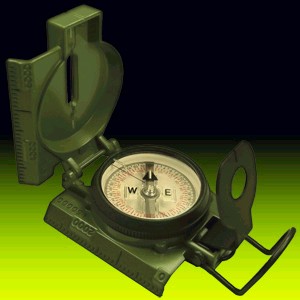
It may be possibly to cut off the lensatic compass's cover, reduce the lens/compass card locking mechanism and STRAP THE WHOLE THING TO YOUR WRIST USING A VERY WIDE BAND OF NYLON. Think a Commando watch band on steroids. The whole device would be about the size of a free fall parachute altimeter. Food for thought and experimentation. The ideal answer would be a Sunnto M9 or NavElite wrist compass with tritium.
Location (GPS)
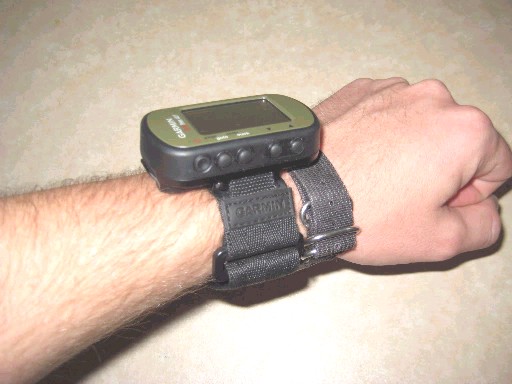
Requirement 7: Tell GPS Coordinates without Draining Batteries Dry
Global Positioning System (GPS) receivers can not only triangulate your exact position from satellite signals, they can offer yet another, slow digital compass to follow during the day time. At night, you cannot be constantly turning the back light on so navigation precision suffers. The best wrist-sized GPS unit is the Garmin Foretrex 401 which is pill-shaped and can also tell the time for you with a back-light and the whole thing is powered by 2 x AAA batteries good for 72 hours (3 days) of operation . The question is are you willing to wear this 3 inch long "pill" on your wrist all the time as your watch? As great as the 401 is, it still requires you to have a topographical map to utilize the coordinates it gives you, though you could use it without a map, schematically using its "electronic bread crumbs" feature.
Suunto offered the XM10 GPS watch but it sucked batteries dry very quickly. Their 2nd Generation Ambit has so far met with rave reviews. Again, Suunto needs to offer a solar assist to their Ambit GPS watches so they can operate longer without battery changes. At $498 on amazon.com the Ambit is not cheap, and one wonders if your money would be better spent on a $200 Foretrex 401 that uses easily available AAA batteries...
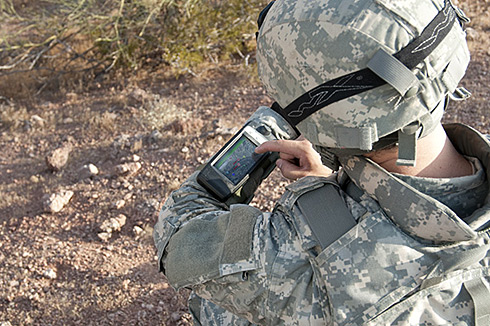
Offering a moving map display takes a LOT of battery power and this is the technical hurdle facing those who want to strap a cell phone aka "smart phone" to every Soldier's wrists to get the visuals. The second challenge is making the Soldier dependant on cell phone signals in enemy lands where friendly towers to cheat and relay signals don't exist. If the Army wants a network it needs to pay for it by long-endurance aircraft like Lighter-Than-Air (LTA) hybrids like they are pioneering now.
In the Soldier's Load equation, it is indeed, a zero sum game where something has to give and not be carried. If a smart phone can offer the function of a watch, compass and GPS then by all means leave the other items home...but the smart phone NEEDS TO BE SOLAR POWER-ASSISTED or else we run the risk of losing all 3 capabilities when the phone dies.
Putting Most of the Requirements Together 1: The Casio Solar G-Shock Model 5802 + Suunto M9 Wrist Compass + G.I. Lensatic Compass [lanyard around neck or in a pouch] Garmin Foretrex 401 [on weapons stock]
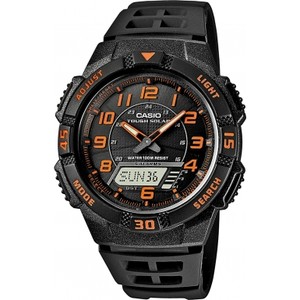
$40 from Wal-Mart--or Less from amazon.com:
amazon.com/Casio-AQS800W-1B2VCF-Solar-Multi-Function-Analog-Digital/dp/B005MDPAPU/ref=cm_cmu_pg_t

Assessing all the requirements, our first answer is to use the Casio Model 5208 Solar-powered digital/analog watch with black face and orange lettering and slide on the Suunto M9 wrist compass.
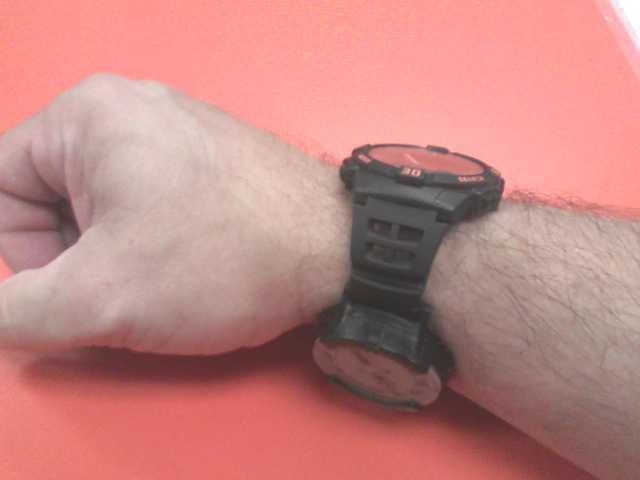
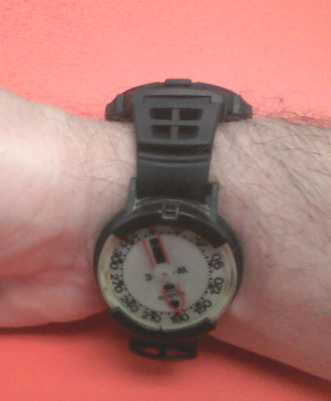
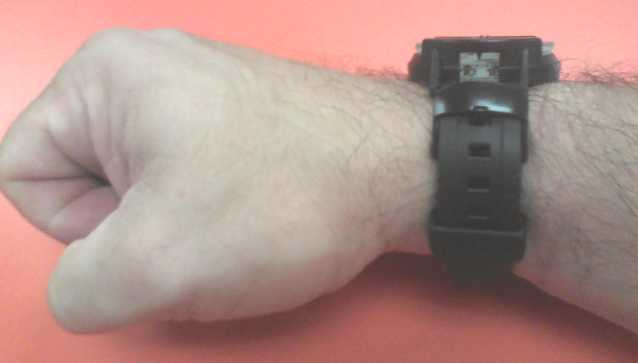
This means only one wrist is encumbered by a band. The solar cell needs the watch face showing as much as possible so the bare metal finish versions are disqualified.
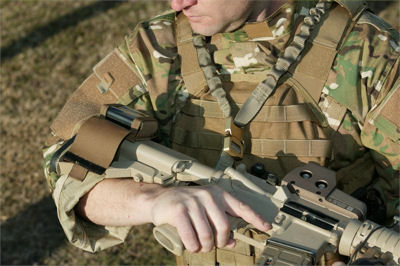
The Garmin Foretrex 401 is on your weapons stock and a G.I. lensatic compass is around your neck on a lanyard or connected to a pouch via the lanyard.
Your laminated topographical map is in a large troop-leader's side pocket of your Multi-Cam ACUs.
 youtube.com/watch?v=jjzy9bruVHg
youtube.com/watch?v=jjzy9bruVHg
The Only Question That Needs to Be Answered:
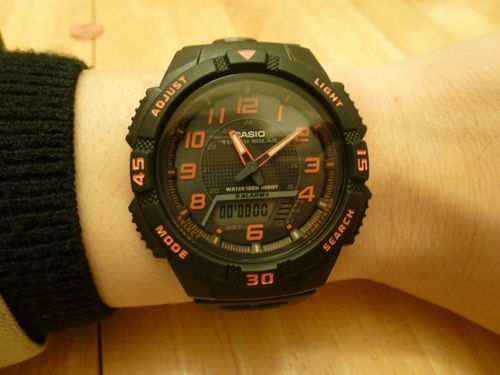 +
+  =
= 